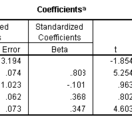Probability and Statistics > Regression Analysis > Standardized Beta Coefficient
What is a Standardized Beta Coefficient?
A standardized beta coefficient compares the strength of the effect of each individual independent variable to the dependent variable. The higher the absolute value of the beta coefficient, the stronger the effect. For example, a beta of -.9 has a stronger effect than a beta of +.8. Standardized beta coefficients have standard deviations as their units. This means the variables can be easily compared to each other. In other words, standardized beta coefficients are the coefficients that you would get if the variables in the regression were all converted to z-scores before running the analysis.

For example, let’s say your model involved how income of parents and their education level affected their offspring’s lifetime earnings. Income of parents is measured in dollars and education level is measured in years of school. Standardizing these variables means that they can be compared to each other in the model. Let’s say income has a standardized beta coefficient with a value of .2 and education level has a beta of .34. The model shows that with every increase of one standard deviation in parent’s income, an offspring’s income rises by .2 standard deviations. This assumes the other variable (education level) is held constant. With an increase of one standard deviation in education level, earnings rise .34 standard deviations — assuming parent’s income is held constant.
Despite the name, it isn’t actually the coefficients that get standardized, but the variables. Betas are calculated by subtracting the mean from the variable and dividing by its standard deviation. This results in standardized variables having a mean of zero and a standard deviation of 1.
Standardized beta coefficients are also called:
- Betas.
- Beta Coefficients.
- Beta Weights.
- Standardized Coefficients.
References
Agresti A. (1990) Categorical Data Analysis. John Wiley and Sons, New York.
Dodge, Y. (2008). The Concise Encyclopedia of Statistics. Springer.
Everitt, B. S.; Skrondal, A. (2010), The Cambridge Dictionary of Statistics, Cambridge University Press.
Lindstrom, D. (2010). Schaum’s Easy Outline of Statistics, Second Edition (Schaum’s Easy Outlines) 2nd Edition. McGraw-Hill Education